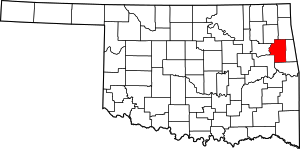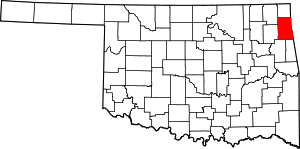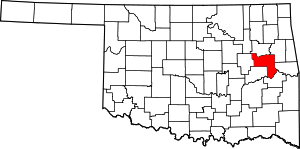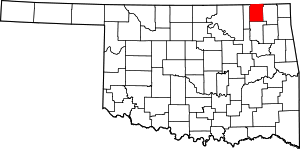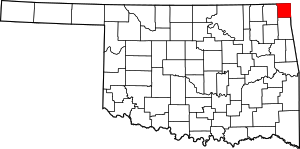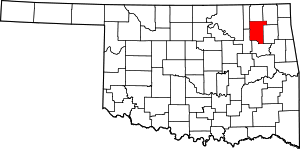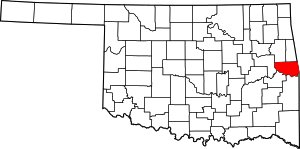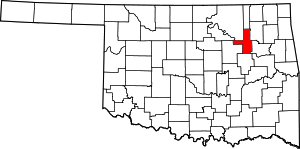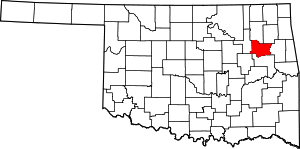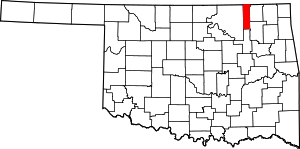Cherokee Nation
The Cherokee Nation (Cherokee: ᏣᎳᎩᎯ ᎠᏰᎵ, Tsalagihi Ayeli or ᏣᎳᎩᏰᎵ "Tsalagiyehli"), also known as the Cherokee Nation of Oklahoma, is the largest of three Cherokee federally recognized tribes in the United States.[3] It was established in the 20th century and includes people descended from members of the Old Cherokee Nation who relocated, due to increasing pressure, from the Southeast to Indian Territory and Cherokee who were forced to relocate on the Trail of Tears. The tribe also includes descendants of Cherokee Freedmen, Absentee Shawnee, and Natchez Nation. Over 299,862 people are enrolled in the Cherokee Nation, with 189,228 living within the state of Oklahoma.[4] In 2009 Larry Echo Hawk, former head of the Bureau of Indian Affairs (BIA), said the current Cherokee Nation is not the historical Cherokee tribe but instead a "successor in interest" which was rejected by the Cherokee Nation.[5] In 2010, Larry Echo Hawk withdrew his previous statement regarding "successor in interest".[6][7]
Cherokee Nation Cherokee Nation of Oklahoma | |
|---|---|
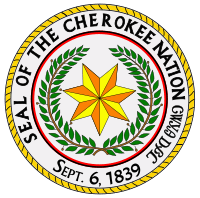 Seal | |
Location (dark blue) in the U.S. state of Oklahoma | |
 Cherokee Nation Location in the United States | |
| Coordinates: 35°51′8″N 94°59′27″W | |
| Constitution | September 6, 1839 |
| Government | |
| • Type | Tribal Council |
| • Principal Chief | Chuck Hoskin, Jr.[1] |
| • Council | Cherokee National Council |
| • U.S. House Delegate-designee | Kimberly Teehee (D) |
| Area | |
| • Total | 6,963 sq mi (18,030 km2) |
| • Land | 6,694 sq mi (17,340 km2) |
| • Water | 269 sq mi (700 km2) |
| Population | |
| • Total | 505,021 |
| Demonym(s) | Cherokee |
| Time zone | UTC−06:00 (CST) |
| • Summer (DST) | UTC−05:00 (CDT) |
| Area code(s) | 918 and 539 |
| Website | cherokee |
Headquartered in Tahlequah, Oklahoma, the Cherokee Nation has a tribal jurisdictional area spanning 14 counties in the northeastern corner of Oklahoma. These are Adair, Cherokee, Craig, Delaware, Mayes, McIntosh, Muskogee, Nowata, Ottawa, Rogers, Sequoyah, Tulsa, Wagoner, and Washington counties.
History
Early modern
During 1898–1906, beginning with the Curtis Act of 1898, the United States federal government all but dissolved the former Cherokee Nation's governmental and civic institutions, to make way for the incorporation of Indian Territory into the new state of Oklahoma. From 1906 to 1938, the structure and function of the tribal government was not clearly defined. After the dissolution of the tribal government of the Cherokee Nation in the 1900s and the death of William Charles Rogers in 1917, the Federal government began to appoint chiefs to the Cherokee Nation in 1919. The service time for each appointed chief was so brief that it became known as "Chief for a Day". Six men fell under this category, the first being A. B. Cunningham who served from November 8 to November 25.[8] The short service times were often just long enough to have one sign a treaty, usually to cede more land.
In the 1930s, the Franklin D. Roosevelt administration worked to improve conditions by supporting the Indian Reorganization Act of 1934, which encouraged tribes to reconstitute their governments and write constitutions. On August 8, 1938, the tribe convened a general convention in Fairfield, Oklahoma to elect a Chief. They choose J. B. Milam as principal chief.[9] President Franklin D. Roosevelt confirmed the election in 1941. W. W. Keeler was appointed chief in 1949. After the U.S. government under President Richard Nixon had adopted a self-determination policy, the nation was able to rebuild its government. The people elected W. W. Keeler as chief. Keeler, who was also the president of Phillips Petroleum, was succeeded by Ross Swimmer. In 1975 the tribe drafted a constitution, under the name Cherokee Nation of Oklahoma, which was ratified on June 26, 1976.[10] The tribe has also conducted litigation using this name.[11] In 1985 Wilma Mankiller was elected as the first female chief of the Cherokee Nation.[12]
Constitutional crisis
The Cherokee Nation was seriously destabilized in May 1997 in what was variously described as either a nationalist "uprising" or an "anti-constitutional coup" instigated by Joe Byrd, the Principal Chief. Elected in 1995, Byrd became locked in a battle of strength with the judicial branch of the Cherokee tribe. The crisis came to a head on March 22, 1997, when Byrd said in a press conference that he would decide which orders of the Cherokee Nation's Supreme Court were lawful and which were not.
A simmering crisis continued over Byrd's creation of a private, armed paramilitary force. On June 20, 1997 his private militia illegally seized custody of the Cherokee Nation Courthouse from its legal caretakers and occupants, the Cherokee Nation Marshals, the Judicial Appeals Tribunal and its court clerks. They ousted the lawful occupants at gunpoint. Immediately the court demanded that the courthouse be returned to the judicial branch of the Cherokee Nation, but these requests were ignored by Byrd.[13] The Federal authorities of the United States initially refused to intervene because of potential breach of tribal sovereignty. The State of Oklahoma recognized that Byrd's activities were breaches in state law. By August, it sent in state troopers and specialist anti-terrorist teams. Byrd was required to attend a meeting in Washington, DC with the Bureau of Indian Affairs, at which he was compelled to reopen the courts. He served the remainder of his elected term. In 1999 Byrd lost the election for Principal Chief to Chad Smith but was elected to the Tribal Council in 2013.
A new constitution was drafted in 1999 that included mechanisms for voters to remove officials from offices, changed the structure of the tribal council, and removed the need to ask the Bureau of Indian Affairs' permission to amend the constitution. The tribe and Bureau of Indian Affairs negotiated changes to the new constitution and it was ratified in 2003. Confusion resulted when the US Secretary of the Interior would not approve it.[14] To overcome the impasse, the Cherokee Nation voted by referendum to amend its 1975/1976 Constitution "to remove Presidential approval authority," allowing the tribe to independently ratify and amend its own constitution.[15] As of August 9, 2007, the BIA gave the Cherokee Nation consent to amend its Constitution without approval from the Department of the Interior.[16] Certain non-Cherokee groups contest the viability of this constitution.
Freedmen controversy
The Cherokee freedmen, descendants of African American slaves owned by citizens of the Cherokee Nation during the Antebellum Period, were first guaranteed Cherokee citizenship under a treaty with the United States in 1866. This was in the wake of the American Civil War, when the US emancipated slaves and passed US constitutional amendments granting freedmen citizenship in the United States. In reaching peace with the Cherokee, who had sided with the Confederates, the US government required that they end slavery and grant full citizenship to freedmen living within their nation. Those who left could become United States citizens. However, in practice, enrollment in the Cherokee Nation rolls was often heavily influenced by race, with freedmen being excluded from land allotments and tribal membership.[17] In a recognition of Cherokee sovereignty, in 1988 the federal court in the Freedmen case of Nero v. Cherokee Nation held that the Cherokee Nation could legally determine its own citizenship requirements, even if that meant excluding descendants of freedmen who had formerly been considered citizens.
On March 7, 2006, the Cherokee Nation Judicial Appeal Tribunal ruled that the Cherokee Freedmen were eligible for Cherokee citizenship. The Cherokee Freedman had historically been recorded as "citizens" of the Cherokee Nation since 1866, and their ancestors were recorded on the Dawes Commission Land Rolls (although generally in the category of Cherokee Freedmen, even if they qualified as "Cherokee by blood", as many did.) The ruling "did not limit membership to people possessing Cherokee blood," as some freedmen and their descendants had never intermarried with Cherokee.[18] This ruling was consistent with the 1975 Constitution of the Cherokee Nation, in its acceptance of the Cherokee Freedmen on the basis of historical citizenship, rather than documented blood relation. The Constitution had always restricted elected governmental positions to persons of Cherokee blood.
On May 15, 2007, the Cherokee Nation Tribal Courts reinstated the Cherokee Freedmen as citizens while appeals were pending in the Cherokee Nation Courts and Federal Court.[19] On May 22, 2007, the Cherokee Nation received notice from the United States Bureau of Indian Affairs that the BIA and Federal Government had denied the amendment to the 1975 Cherokee Nation Constitution because it required BIA approval, which had not been obtained. The BIA also noted that the Cherokee Nation had excluded the Cherokee Freedmen from voting on the amendment. On this issue, the Cherokee Nation Supreme Court ruled that the Cherokee Nation could take away the approval authority which it had previously granted the federal government. Pending the resolution of litigation, the Cherokee Freedman had all rights as full Cherokee Nation citizens, including voting rights and access to tribal services.[20] In early 2011, the tribal district court ruled that the special election in 2007 on the constitutional amendment was unconstitutional, as it excluded Freedmen from voting. The Nation appealed. On August 22, 2011, the Cherokee Supreme Court upheld the results of the 2007 special election. Chuck Trimble, a former executive director of the National Congress of American Indians, characterized the decision as the "Cherokee Dred Scott Decision", for depriving a group of citizenship.[21]
At the same time, the Cherokee Supreme Court ordered a special run-off election to be held September 24, 2011 to settle the office of Principal Chief. Earlier voting in this year's election had been so close that the incumbent Chad Smith and challenger Bill John Baker, longtime Cherokee National Council member, had each twice been declared the winner. On September 11, the Nation sent letters to Freedmen, notifying them of their loss of citizenship and voting rights. The US Department of Housing and Urban Development froze $33 million in funds to the Cherokee Nation while studying the case, pursuant to a stipulation in the 2008 Congressional renewal of Self-Determination Act. On September 13, the Department of the Interior strongly urged the Cherokee Nation to restore voting rights and benefits to descendants of Cherokee Freedmen, including the right to vote in the special election for principal chief, at the risk of violating its constitution and the US Constitution.[22] On September 14, the Cherokee AG recommended reinstatement of the Freedmen, pending a hearing for oral arguments.[23] On September 20, Judge Henry Kennedy of the US District Court announced the Cherokee Nation, Freedmen plaintiffs and US government had come to an agreement in a preliminary hearing to allow the Freedmen to vote, with voting to continue through October 5 if necessary.[24] On August 30, 2017, the United States District Court for the District of Columbia ruled in favor of the Freedmen descendants and the U.S. Department of the Interior, granting the Freedmen descendants full rights to citizenship in the Cherokee Nation. The Cherokee Nation has accepted this decision, effectively ending the dispute.
Reservation reconstituted
On July 9, 2020, the United States Supreme Court ruled in a 5–4 decision that the original treaties, and promise of a reservation, with the Five Civilized Tribes (specifically the Muscogee in McGirt v. Oklahoma) were never withdrawn. This decision restored the reservation status of the Cherokee Nation and, as such, relinquished legal jurisdiction from the State of Oklahoma of Native American citizens on the previously designated land. The majority opinion was held by justices Sonia Sotomayor, Ruth Bader Ginsburg, Elena Kagan, Stephen Breyer, and Neil Gorsuch. [25][26]
Cherokee Nation Principal Chief Chuck Hoskin, Jr. made the statement: “We have long held that Cherokee Nation has a reservation, rooted in our treaties, as the Supreme Court of the United States has now affirmed” and “This proposed legislation will cement our reservation boundaries and the broad tribal jurisdiction the Supreme Court recognized in the McGirt decision. We will continue to work with the state of Oklahoma and our federal partners to ensure the safety of the public.” [27]
Environment
Today the Cherokee Nation is one of the United States' leading proponents for ecological protection. Since 1992, the Nation has served as the lead for the Inter-Tribal Environmental Council.[28] The mission of ITEC is to protect the health of American Indians, their natural resources and their environment as it relates to air, land and water. To accomplish this mission, ITEC provides technical support, training and environmental services in a variety of environmental disciplines. Currently, there are more than 40 participating tribes in ITEC from Oklahoma, New Mexico, and Texas.[29] As of 2014, the Cherokee Seed Project of the Natural Resources Department offers "two breeds of corn, two kinds of beans (including Trail of Tears beans), two gourds and medicinal tobacco" to Cherokee Nation members.[30]
Demographics

Population
Race and blood quantum are not factors in Cherokee Nation tribal citizenship eligibility. To be considered a citizen in the Cherokee Nation, an individual needs a direct ancestor listed on the Dawes Rolls as a citizen of the Nation, whether as a Cherokee Indian or as one of the Cherokee Freedmen.[31] The tribe currently has members who also have some degree of African, Latino, Asian, white and other ancestry. In the case of the Cherokee Freedmen, members may be predominantly or wholly African-American. Members of the Natchez Nation joined the Cherokee Nation, as did other southeastern tribes in the 18th century.[32]
Language

The Cherokee Nation instigated a 10-year language preservation plan that involved growing new fluent speakers of the Cherokee language from childhood on up through school immersion programs as well as a collaborative community effort to continue to use the language at home.[33] This plan was part of an ambitious goal that in 50 years, 80% or more of the Cherokee people will be fluent in the language.[34] The Cherokee Preservation Foundation has invested $3 million into opening schools, training teachers, and developing curricula for language education, as well as initiating community gatherings where the language can be actively used.[34] Formed in 2006, the Kituwah Preservation & Education Program (KPEP) on the Qualla Boundary focuses on language immersion programs for children from birth to fifth grade, developing cultural resources for the general public and community language programs to foster the Cherokee language among adults.[35] There is also a Cherokee language immersion school in Tahlequah, Oklahoma that educates students from pre-school through eighth grade.[36]
Several universities offer Cherokee as a second language, including the University of Oklahoma, Northeastern State University, and Western Carolina University. Western Carolina University (WCU) has partnered with the Eastern Band of Cherokee Indians (EBCI) to promote and restore the language through the school's Cherokee Studies program, which offers classes in and about the language and culture of the Cherokee Indians.[37] WCU and the EBCI have initiated a ten-year language revitalization plan consisting of: (1) a continuation of the improvement and expansion of the EBCI Atse Kituwah Cherokee Language Immersion School, (2) continued development of Cherokee language learning resources, and (3) building of Western Carolina University programs to offer a more comprehensive language training curriculum.[37]
Family structure
On June 14, 2004, the Cherokee Nation Tribal Council voted to officially define marriage as a union between a woman and man, thereby outlawing same-sex marriage. This decision came in response to an application by a lesbian couple submitted on May 13. The decision kept Cherokee law in line with Oklahoma state law, which in 2004 passed a referendum on a constitutional amendment excluding gay marriage as legal. On December 9, 2016 same-sex marriage was immediately legalized through an opinion by Todd Hembree, the Cherokee Nation's attorney general. In the opinion, Hembree stated that the 2004 law violated the Cherokee Constitution, which requires the equal treatment of tribal citizens. The opinion was issued because the director of the tribe's tax commission sought a decision from Hembree whether the tribe could issue a vehicle tag to a same-sex couple married outside the tribe's jurisdiction.[38][39]
Government
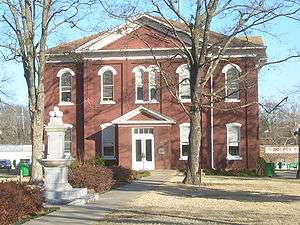
The Cherokee Nation has legislative, executive and judicial branches with executive power vested in the Principal Chief, legislative power in the Tribal Council, and judicial power in the Tribal Supreme Court. The tribe's democratically elected government, led by a Principal Chief, Deputy Chief, and Tribal Council. The current Principal Chief, elected June 1, 2019, is Chuck Hoskin, Jr., who formerly held the office of Cherokee Nation Secretary of State.[1]
Two tribal council members represent the at-large citizenry – those who live outside the tribe's 14-county jurisdictional area in northeastern Oklahoma. Eleven satellite communities have been organized by the tribe in areas of high Cherokee Nation populations. These communities are composed of a majority of enrolled Cherokee Nation citizens. These communities are a way for enrolled Cherokee citizens to connect with Cherokee heritage and culture, and to be more politically engaged. These communities are located in Arizona, California, Colorado, New Mexico, Texas, Florida, and central Oklahoma.[40]
The executive branch is also composed of five independent agencies which exercise power autonomously from the control of the Principal Chief:
- Tax Commission
- Election Commission
- Environmental Protection Commission
- Gaming Commission
- The Cherokee Phoenix

The principal chief is the head of the executive branch of the Cherokee National Government, responsible for overseeing an annual budget of over $600 million and more than 3,000 full-time employees. The deputy chief acts as the chief in his or her absence. The chief is assisted in managing the executive branch by the Secretary of State, the Attorney General, the Marshal, the Treasurer, and several group leaders. The government's functions are divided into several Groups, each headed by a Group Leader. These groups are further divided into several Service Areas which provide governmental services to the Cherokee people. As of July 2011, there are fifteen groups:
- Education Services Group – oversees all early childhood development programs, cultural and historical preservation efforts, higher education scholarships, and operates several schools for Cherokee students
- Health Services Group – provides direct care and community health services, including the operation of eight regional health clinics and one central hospital facility
- Financial Resources Group – central accounting, budgeting, and acquisition services for the entire Government
- Community Services Group – provides public transit services, constructs road and sanitary sewer infrastructure projects, environmental health services, and self-help housing assistance
- Management Resources Group – provides centralized support services to the entire government, including facilities management, risk management, natural resources preservation, and long range planning and development
- Commerce Services Group – operates the Nation's Small Business Assistance Center which provides financial support to Cherokee-owned business, provides mortgage assistance to Cherokee homebuyers, and promotes cultural tourism
- Human Services Group – provides family assistance programs, child support services, child care centers, child welfare and protective services, and veterans affairs services
- Government Resources Group – oversees funds received from the Federal Government, manages all Tribal property, and oversees Tribal registration
- Housing Services Group – operates low-income and elderly rental property for citizens, provides rehabilitation to private homes, provides mortgage assistance to citizens, and provides subsidy for rental properties
- Career Services Group – provides job training, job relocation assistance, vocational rehabilitation, and operates "Talking Leaves" Job Corps Facility
- Leadership Services Group – operates the Cherokee Ambassador program, manages the Cherokee National Youth Choir, the Cherokee Youth Leadership Council, and various Summer Camps
- Office of the Attorney General – provides legal advice and representation to the Tribe and prosecutes violators of Tribal law
- Cherokee Marshal Service – provides full service law enforcement services to the Nation
- Human Resources Group – provides centralize personnel management for all employee recruitment and management affairs of the government
- Information Systems Group – provides centralized information technology management for the government
The judicial branch of tribal government includes the District Court and Supreme Court, which is comparable to the U.S. Supreme Court. The Supreme Court consists of five members who are appointed by the Principal Chief and confirmed by the council. It is the highest court of the Cherokee Nation and oversees internal legal disputes and the District Court. The District Judge and an Associate District Judge preside over the tribe's District Court and hear all cases brought before it under jurisdiction of the Cherokee Nation Judicial Code. Cherokee Nation has two tribal courts, the District Court and the Supreme Court. The Cherokee Nation Marshal Service polices the tribe. A wide range of tribal businesses are operated by Cherokee Nation Entertainment (CNE) and Cherokee Nation Businesses (CNB), based in Catoosa, Oklahoma[41][42] and Cherokee Nation Industries (CNI), based in Stilwell, Oklahoma.[43] The tribal newspaper is the Cherokee Phoenix. The Cherokee Nation operates Sequoyah High School and W. W. Hastings Hospital, both based in Tahlequah. The Nation also operates a medical clinic, the Wilma P. Mankiller Clinic, and Maryetta School in Stilwell.
The Congress of the United States, the federal courts, and state courts have repeatedly upheld the sovereignty of Native Tribes, defining their relationship in political rather than racial terms, and have stated it is a compelling interest of the United States.[44] This principle of self-government and tribal sovereignty is controversial. According to the Boston College sociologist and Cherokee, Eva Marie Garroutte, up to 32 separate definitions of "Indian" are used in federal legislation, as of a 1978 congressional survey.[45] The 1994 Federal Legislation AIRFA (American Indian Religious Freedom Act) defines an Indian as one who belongs to an Indian Tribe, which is a group that "is recognized as eligible for the special programs and services provided by the United States to Indians because of their status as Indians."
The Principal Chief, Deputy Chief, and Tribal Council are elected to four-year terms by the registered tribal voters over the age of 18. The council is the legislative branch of government and represents the five districts of the Cherokee Nation in the 14 county tribal jurisdictional area, with each district having three councilors. Two council members represent the at-large community who live outside the 14-county area. In October 2011, Bill John Baker was elected Principal Chief for a four-year term.
The Cherokee Nation also has the right to appoint a delegate to the U.S. House of Representatives, per the 1835 Treaty of New Echota. In 2019, Kimberly Teehee was appointed the first ever delegate to the U.S. House of Representatives from the Cherokee Nation, in accordance with the 1835 treaty, though Congress has not yet passed the legislation required to seat her.
Inter-tribal relations
Inter-tribal membership
The Cherokee Nation participates in numerous joint programs with the Eastern Band of Cherokee Indians, including cultural exchange programs and joint Tribal Council meetings involving councilors from both Cherokee tribes that address issues affecting all Cherokee people. The United Keetoowah Band tribal council unanimously passed a resolution to approach the Cherokee Nation for a joint council meeting between the two nations, as a means of "offering the olive branch," in the words of the UKB Council. While a date was set for the meeting between members of the Cherokee Nation council and UKB representation, Chief Chad Smith vetoed the meeting.
The Delaware Tribe of Indians (Lenape) became part of the Cherokee Nation in 1867. On 28 July 2009 it achieved independent federal recognition as a tribe.[46][47] Similarly, the Shawnee Tribe separated from the Cherokee Nation and achieved federal recognition in the 20th century. The Cherokee Nation strongly opposes further federal or state recognition of other Cherokee groups. This is despite some of these groups having signed treaties in the past. The Cherokee Nation believes that this would jeopardize tribal sovereignty.
On April 9, 2008, the Councils of the Cherokee Nation and the Eastern Band of Cherokee Indians at the Joint Council Meeting held in Catoosa, Oklahoma passed a resolution: "Opposing Fabricated Cherokee 'Tribes' and 'Indians'".[48] It denounced further state or federal recognition of so-called Cherokee tribes or bands. These tribes committed to exposing and assisting state and federal authorities in eradicating any group that attempts or claims to operate as a government of the Cherokee people. The resolution asked that no public funding from any federal or state government should be expended on behalf of non-federally recognized Cherokee tribes or bands. The Nation stated it would call for a full accounting of all federal monies given to state recognized, unrecognized or 501(c)(3) charitable organizations that claimed any Cherokee affiliation. It called for federal and state governments to stringently apply a federal definition of "Indian", to include citizens of federally recognized Indian tribes, to prevent non-Indians from selling membership in so-called Cherokee tribes for the purpose of exploiting the Indian Arts and Crafts Act of 1990. In a controversial segment that could affect Cherokee Baptist churches and charitable organizations, the resolution stated that no 501(c)(3) organization, state recognized, or unrecognized groups shall be acknowledged as Cherokee.
The resolution challenged celebrities who claim Cherokee ancestry (Examples are in the "List of self-identified Cherokee".)
- "Any individual who is not a member of a federally recognized Cherokee tribe, in academia or otherwise, is hereby discouraged from claiming to speak as a Cherokee, or on behalf of Cherokee citizens, or using claims of Cherokee heritage to advance his or her career or credentials." – Joint Council of the Cherokee Nation and the Eastern Band of the Cherokee Indians[49]
The United Keetoowah Band did not sign or approve the resolution. The Cherokee Nation acknowledges the existence of people of Cherokee descent "... in states such as Arkansas, Kansas, Missouri, and Texas," who are Cherokee by ancestry but who are not considered members of the Cherokee Nation.[50]
There are more than 200 groups that we've been able to recognize that call themselves a Cherokee nation, tribe, or band," said Mike Miller, spokesman for the Cherokee Nation. "Only three are federally recognized, but the other groups run the gamut of intent. Some are basically heritage groups – people who have family with Cherokee heritage who are interested in the language and culture, and we certainly encourage that," said Miller. "But the problem is when you have groups that call themselves 'nation', or 'band', or 'tribe', because that implies governance.
Tribal heritage groups
Many groups have sought recognition by the federal government as Cherokee tribes, but today there are only three groups so recognized. Cherokee Nation spokesman Mike Miller has said that some groups, which he calls Cherokee Heritage Groups, are encouraged.[51] Others have created controversy by their attempts to gain economically through their claims to be Cherokee. The three federally recognized groups say that only they have the legal right to present themselves as Cherokee Indian Tribes.[52]
Prior to 1975, the Texas Cherokees and Associate Bands-Mount Tabor Indian Community (TCAB-MTIC) were considered a part of the Cherokee Nation, as reflected in briefs filed before the Indian Claims Commission. While W.W. Keeler served as Chief of the Cherokee Nation, he also was Chairman of the TCAB Executive Committee. The TCAB was formed as a political organization in 1871 by William Penn Adair and Clement Neely Vann, for descendants of the Texas Cherokee and the Mount Tabor Community. They wanted to gain redress from treaty violations, stemming from the Treaty of Bowles Village of 1836.
Following the Cherokee Nation's adoption of a constitution in 1975, it excluded from tribal membership those Mount Tabor descendants whose ancestors had remained a part of the physical Mount Tabor Indian Community in Rusk County, Texas. This was based on their ancestors not having been recorded on the Final Rolls of the Five Civilized Tribes, as documented by the US government. The Mount Tabor Indian Community does not consider itself to be a Cherokee tribe and only recognizes the three federally recognized Cherokee groups as legitimate "Cherokee tribes". Although the founding families were Cherokee by blood from 1850 and into contemporary periods the community has evolved into a distinct multi-tribal band with large percentages of Yowani Choctaw, Chickasaw and Muscogee Creek Indians. The Mount Tabor Indian Community was recognized as a tribe by the State of Texas in 2017.[53] Cherokee descendants of the Mount Tabor Indian Community must trace lineal descent from one or more of the six progenitor families. All Cherokees are documented through ancestral enrollment on either the Old Settler Payment Roll or the Guion Miller Roll.
Economy
The Cherokee Nation controls Cherokee Nation Businesses, a holding company which owns companies in gaming, construction, aerospace and defense, manufacturing, technology, real estate, and healthcare industries. The Nation also operates its own housing authority and issues Tribal vehicle and boat tags. The Cherokee Nation's estimated annual economic impact is $1.06 billion on the state's economy, $401 million in salaries, and supports 13,527 Cherokee and non-Cherokee jobs.[54] In recent times, the modern Cherokee Nation has experienced an almost unprecedented expansion in economic growth and prosperity for its citizens. The Cherokee Nation has significant business, corporate, real estate, and agricultural interests, helping to produce revenue for economic development and welfare.
Culture
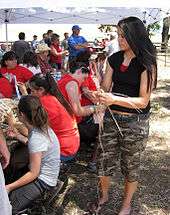
The Cherokee Nation council appropriates money for historic foundations concerned with the preservation of Cherokee culture, including the Cherokee Heritage Center. It operates living history exhibits including a reconstructed ancient Cherokee village, Adams Rural Village (a turn-of-the-century village), Nofire Farms, and the Cherokee Family Research Center for genealogy, which is open to the public.[55] The Cherokee Nation hosts the Cherokee National Holiday on Labor Day weekend each year, attracting 80,000 to 90,000 Cherokee to Tahlequah for the festivities.[56]
Art
The Cherokee Heritage Center is home to the Cherokee National Museum, which has numerous exhibitions also open to the public. The CHC is the repository for the Cherokee Nation as its National Archives. The CHC operates under the Cherokee National Historical Society, Inc., and is governed by a Board of Trustees with an executive committee. The nation also supports the Cherokee Nation Film Festivals in Tahlequah and participates in the Sundance Film Festival in Park City, Utah.
Media
The Cherokee Nation publishes the Cherokee Phoenix, currently a monthly newspaper. The paper has operated nearly continuously since 1828, publishing editions in both English and the Cherokee syllabary (also known as the Sequoyah syllabary). It holds historical significance as both the first newspaper to be published by Native Americans in the United States and the first to be published in a Native American language.[57]
Health
The Cherokee Nation has constructed health clinics throughout Oklahoma, contributed to community development programs, built roads and bridges, constructed learning facilities and universities for its citizens, instilled the practice of Gadugi and self-reliance, revitalized language immersion programs for its children and youth, and is a powerful and positive economic and political force in Eastern Oklahoma. In the early 21st century, the tribe assumed control of W. W. Hastings Hospital in Tahlequah, previously operated by the US Indian Health Service.[58]
Notable people
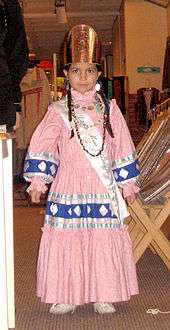

- Bud Adams (1923–2013), businessman and owner of the Tennessee Titans and Houston Oilers
- Tommy Allsup, swing/rockabilly musician[59]
- Bill John Baker, Principal Chief (2011–2019), businessman, and tribal councilperson
- Lena Blackbird, basket maker
- Martha Berry, beadwork artist
- Roy Boney Jr. (b. 1978), artist, animator, comic book illustrator, language advocate
- Sam Bradford (b. 1987), quarterback, winner of the Heisman Trophy
- Dylan Bundy, pitcher for the Baltimore Orioles
- Linda Burhansstipanov, public health educator and researcher focused on Native American cancer care and support
- Joe Byrd, Principal Chief (1995–1999), tribal councilor and speaker
- Brad Carson (b. 1967), Oklahoma congressman
- Admiral Joseph J. Clark (1893–1971), United States Navy, highest-ranking Native American in the US military.
- Mike Dart (b. 1977), basket weaver
- Talmadge Davis (1962–2005), painter
- Mavis Doering (1929–2007), basket weaver
- Joseph L. Erb (b. 1974), artist, 3-D animator, Cherokee language advocate, professor
- Angel Goodrich (b. 1990), WNBA basketball player
- John Tyler Hammons (b. 1988), mayor of Muskogee, Oklahoma
- Chuck Hoskin (b. 1952), Oklahoma Democratic state legislator
- Sharon Irla (b. 1957), painter
- Daniel Heath Justice, author and professor
- W. W. Keeler (1908–1987), Principal Chief
- Adrienne Keene, author and professor, creator of Native Appropriations
- Stacy Leeds, justice on the Cherokee Nation Supreme Court, judge for three tribal courts, law professor
- Litefoot, rapper and actor
- Wilma Mankiller (1945–2010), Principal Chief and author
- Barbara McAlister (b. 1941), mezzo-soprano opera singer
- J. B. Milam (1884–1949), Principal Chief
- Anna Belle Sixkiller Mitchell (1926–2012), ceramic artist
- America Meredith (1972), artist, curator, and editor
- Markwayne Mullin (b. 1977), Oklahoma congressman
- Lloyd Kiva New (1916–2002), artist, fashion designer, co-founder of the Institute of American Indian Arts
- Will Rogers Jr. (1911–1993), journalist, entertainer, and California congressman
- William Sanders (writer) (b. 1942), author
- Sonny Sixkiller (b. 1951), football player
- Chad Smith, Principal Chief and attorney
- Hastings Shade (1941–2010), Deputy Chief, traditionalist, language expert, artist, and National Treasure
- Kevin Stitt, Governor of the state of Oklahoma[60]
- Ross Swimmer, Principal Chief and Special Trustee for American Indians at the U.S. Department of the Interior
- Wes Studi (b. 1947), actor, musician, Native American rights advocate
- Kimberly Teehee (b. 1969/70), political advisor and official
- Kay WalkingStick (b. 1935), painter and educator
- Madison Whitekiller, Junior Miss Cherokee 2015–16, Miss Cherokee 2017–18
- Tommy Wildcat, Native American flutist, traditionalist
See also
- List of federally recognized tribes
- List of Indian reservations in the United States
- List of Native American tribes in Oklahoma
References
- Rowley, D. Sean (June 2, 2019). "Hoskin wins Cherokee Nation principal chief race". Cherokee Phoenix. Tahlequah, Oklahoma. Retrieved June 2, 2019.
- "U.S. Census website". Retrieved June 9, 2017.
- "Cherokee Nation Home". Cherokee Nation Website. Retrieved July 10, 2020.
- "Wayback Machine" (PDF). January 20, 2013. Archived from the original (PDF) on January 20, 2013. Retrieved July 10, 2020.
- Indian Country Today Archived October 7, 2009, at the Wayback Machine
- Chavez, Will. "BIA decision says United Keetoowah Band can seek trust land". Cherokee Phoenix. Cherokee Phoenix. Retrieved July 21, 2020.
- "Cherokee Nation v. S.M.R. Jewell". National Indian Law Library. Section 4, Footnotes 16: Native American Rights Fund. May 31, 2017. Retrieved July 21, 2020.CS1 maint: location (link)
- Conley, Robert J. (2005). The Cherokee Nation: a history. p. 203.
- Meredith, Howard L. Modern American Indian Tribal Government. Tsaile, AZ: Navajo Community College Press, 1993: 20. ISBN 0-912586-76-1.
- "Constitution of the Cherokee Nation of Oklahoma". Cherokee Nation of Oklahoma. 1975. Retrieved January 16, 2010.
- "Cherokee Nation of Oklahoma et al. v. Leavitt et al" (PDF). Supreme Court of the United States. March 2005. Retrieved July 4, 2007.
- Women of the Hall National Women's Hall of Fame. (retrieved June 21, 2009)
- Yardley, Jim (August 14, 1999). "After Years of Division, Cherokees Get a New Leader". New York Times.
- Hales, Donna. "Cherokee Constitution in doubt", Muskogee Phoenix. 7 September 2006 (retrieved 16 June 2009)
- "The 1999 Constitution Cherokee Nation" Archived March 27, 2009, at the Wayback Machine, Cherokee Nation. (retrieved 16 June 2009)
- "Letter from Carl Altman, 8-9-2007" (PDF). Archived from the original (PDF) on November 27, 2007. Retrieved September 7, 2007.
- Nicholas Frye. "Applying for Cherokee Citizenship: Constructing Race, Nation, and Identity, 1900–1906" (PDF).
- "Freedman Decision" (PDF). Archived from the original (PDF) on February 13, 2007. Retrieved March 10, 2007.
- "Cherokee Courts Reinstate Freedmen".
- Citizenship Status of Non-Indians. Archived July 25, 2009, at the Wayback Machine Cherokee Nation. (retrieved 22 July 2009)
- Chuck Trimble, "The Cherokee Dred Scott Decision" Archived July 22, 2012, at the Wayback Machine, Indian Country Today, 18 September 2011, accessed 20 September 2011
- Associated Press, "Cherokees Told To Take Back Slaves' Descendants", 13 September 2011, HeraldNet, accessed 6 April 2020
- Steve Olafson, "Cherokee tribe retreats from effort to oust some members", Reuters, 15 September 2011, accessed 20 September 2011
- Molly O'Toole, "Cherokee tribe reaches agreement to reinstate 2,800 'Freedmen'", Reuters, 20 September 2011, accessed 21 September 2011
- Healy, Jack; Liptak, Adam (July 9, 2020). "Landmark Supreme Court Ruling Affirms Native American Rights in Oklahoma". The New York Times. Retrieved July 20, 2020.
- "McGirt v. Oklahoma" (PDF). United States Supreme Court.
- Hunter, Chad. "5 Tribes, state seek 'shared position' on jurisdiction after McGirt case" (17 July 2020). Cherokee Phoenix. Retrieved July 20, 2020.
- "Inter-Tribal Environmental Council". Retrieved March 10, 2007.
- "Inter-Tribal Environmental Council". Inter-Tribal Environmental Council. Archived from the original on May 16, 2001.
- Keesee, Kellie (January 16, 2014). "Cherokee seed project sows respect for the past, hope for the future". Eatocracy – CNN.com Blogs. Archived from the original on January 19, 2014. Retrieved January 19, 2014.
- "Tribal Citizenship". Cherokee Nation. Archived from the original on November 16, 2019. Retrieved September 24, 2017.
- Natchez Indian Tribe History. Access Genealogy. (retrieved 16 June 2009)
- "Native Now : Language: Cherokee". We Shall Remain – American Experience – PBS. 2008. Retrieved April 9, 2014.
- "Cherokee Language Revitalization". Cherokee Preservation Foundation. 2014. Archived from the original on April 7, 2014. Retrieved April 9, 2014.
- Kituwah Preservation & Education Program Powerpoint, by Renissa Walker (2012)'. 2012. Print.
- Chavez, Will (April 5, 2012). "Immersion students win trophies at language fair". Cherokeephoenix.org. Retrieved April 8, 2013.
- "Cherokee Language Revitalization Project". Western Carolina University. 2014. Archived from the original on April 7, 2014. Retrieved April 9, 2014.
- "Cherokee AG: Tribe must recognize same-sex marriage". Tahlequah Daily Press. December 11, 2016. Retrieved December 12, 2016.
- "Cherokee Attorney General rules gay marriage bans unconstitutional". Reuters. December 12, 2016. Retrieved December 12, 2016.
- Cherokee Communities. Archived July 13, 2009, at the Wayback Machine Cherokee Nation. (retrieved 16 June 2009)
- Cherokee Nation Enterprises, Inc. Business Week. 2009 (retrieved 22 July 2009)
- "Cherokee Nation Businesses".
- Cherokee Nation Industries. 2007. (retrieved 22 July 2009)
- State of Utah Court Case Archived September 29, 2007, at the Wayback Machine
- Garroutte, p.16
- Dowell, JoKay. "Delawares pass constitution, move closer to federal recognition", Native American Times. (retrieved 16 June 2009)
- "Delaware Tribe regains federal recognition", NewsOk. 4 Aug 2009 (retrieved 5 August 2009)
- "Cherokee.org". Archived from the original on March 1, 2009. Retrieved February 20, 2009.
- Joint Council of the Cherokee Nation and the Eastern Band of Cherokee Indians. Resolution #00-08. A Resolution Opposing Fabricated Cherokee "Tribes" and "Indians".
- Cherokee.org Archived February 21, 2009, at the Wayback Machine
- Glenn 2006
- Official Statement Cherokee Nation 2000, Pierpoint 2000
- "Texas Legislature Online – 85(R) Actions for SCR 25". www.legis.state.tx.us.
- Cherokee Nation 2010 Economic Impact Report, Cherokee Nation, prepared by the Oklahoma City University Meinders School of Business, 2012
- "Cherokee Heritage Center". Retrieved March 10, 2007.
- "Cherokee National Holiday". Cherokee Nation. Retrieved November 8, 2019.
- Angela F. Pulley, Cherokee Phoenix, New Georgia Encyclopedia
- Adcock, Clifton. "Judge throws out suit challenging Cherokee control of hospital", Tulsa World, 2 June 2009 (retrieved 26 2009)
- "11th Annual Native American Music Awards nominees announced". Indian Country Today Media Network. September 23, 2009. Retrieved July 1, 2016.
- "Only one state makes history with election of first Native governor". Indianz.Com. November 7, 2018. Retrieved December 16, 2018.
External links
- Government
- General information
- Cherokee Nation articles in the archive of the Chicago Tribune
- Cherokee Nation Businesses
- Cherokee Nation Fish and Wildlife Association
- Cherokee Nation Foundation
- Housing Authority of the Cherokee Nation


